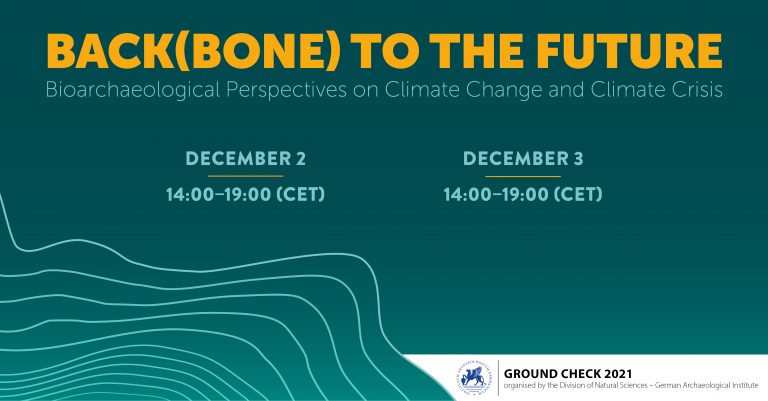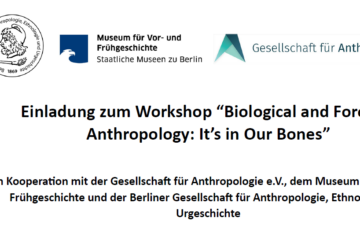#BioarchClimateConference #ClimateChange #ClimateCrisis #Bioarchaeology #NaturalSciences_DAI #Groundcheck @dai_weltweit

On the 2nd and 3rd of December 2021, the Human Bioarchaeology Unit (Division of Natural Sciences, German Archaeological Institute) organised the free online conference “Back(Bone) to the Future – Bioarchaeological Perspectives on Climate Change and Climate Crisis”. The conference presented a global, long-term perspective on climate change and climate crisis from the point of view of those who experienced it in the past, of those who study the remains of these past eyewitnesses and those that see it happening today. 24 speakers and 116 attendees from all over the world created a lively discussion on a wide range of transdisciplinary approaches to climate change and climate crisis. From the alarming disappearance of biocultural heritage to the way climate crises shape our social structure, the conference showed the need to use scientific evidence in a proactive way. Communicating the results of bioarchaeological research helps to prevent misinformation by making data accessible not only to a scholarly audience but to the wider public. Within this engaged perspective, the involvement of local communities represents a crucial step.
Three Keynote Lectures were held by leading researchers in the field: Gwen Robbins Schug (Appalachian State University / University of North Carolina), Choongwon Jeong (Seoul National University) and Ryan Harrod (Garrett College / University of Alaska Anchorage). Papers were presented in four thematic sessions by 24 scientists with various specialties, presenting cases from five continents and multiple millennia.
In Session 1: “Threatened Bioarchives: Climate Change and (Bio)Cultural Heritage”, the focus was on the threats that climate change and climate crisis currently have and will increasingly have on the long-term survival of ancient and recent bioarchives, such as buried biogenic remains. From iconic figures, such as “Ötzi, the Iceman”, the thawing (bio)heritage of Greenland and drying wetland sites to tropical shell mounds and other coastal and inland burial places, many sites are increasingly endangered or already destroyed by melting glaciers, rising sea levels, coastal erosion, flooding, droughts and overall global warming. It became apparent that raising public awareness about these sometimes hidden threats must be one of the key strategies for preserving the future of our (bio)cultural heritage.
In Session 2: “From Climate Riders to Climate Refugees: Climate Change and Human Evolution”, the dispersal of different species of Homo all over the globe was discussed, as well as the climatic changes that have affected human evolution. The ancestral human journey from Africa to Asia and beyond posed both environmental challenges and adaptive opportunities, which humans have weathered by different means at different times. One of the key characteristics of humans as a biological and cultural species has indeed been adaptability: humans adapting to the environment as well as adapting the latter to human needs. The switch from foraging to farming and further switches between crops adapted to different climates are just a few illustrative examples of this. Today, increasingly fast human-driven climatic changes are responsible for the displacement of people and the uprooting of entire social and cultural systems in the regions where human evolution began and ever further afield.
In Session 3: “Under the Weather: Climate Change and (Human) Health”, the complex relationship between these two concepts was explored from different angles, incorporating non-human species that can serve as proxies for climate change and physiological climate stress. Parasites are prime examples of non-human species that can burden human populations in their adaptive niches, while respiratory diseases are a common indicator of disadvantageous living conditions in natural and anthropic environments. In regions that become increasingly inhospitable due to a changing climate, some species fail to adapt and become partly extinct, while human resilience and inventiveness again allow(ed) utilisation of marginal areas where the global effects of the current climate crisis are felt the most. By further linking climate change and health effects through time, we can increase our understanding of these highly complex interrelations for both past and future human lives.
Session 4: “Rising Temperatures and Rising Tensions? Climate Change and Violence”, mainly examined the scars of past human violence directed against others as a possible response to times of climate-induced crises, for example droughts and famines. While (bio)archaeological evidence of violence is often interpreted as a result of increased competition over available but limited resources in times of stress, human responses are highly variable and always a result of highly complex and specific cultural interrelations. A worsening climate is recognised as a threat to current international peace and security, and it was likely also the same at various times in the past, although in these cases, a changing climate often only exacerbates already existing social inequalities. It follows, especially from a context-focussed bioarchaeological point of view, that making sweeping and simplistic generalisations based on sites or regions with clear evidence for mass violence are not a valid way to explain or describe other regions where biocultural conditions and inter- and intra-group relations were certainly different. While violence against others is one graphic and potentially archaeologically visible way of responding to subsistence crises, it is not the only and likely not the most frequently chosen one.
This conference promoted global perspectives on how changes in climatic conditions were deeply intertwined with human existence, their adaptive strategies and what the effects of human-driven climate change have been and will be. By including multidisciplinary contributions from (bio)archaeological, medical and sociocultural sciences as well as larger overviews and specific case studies from many parts of the world, it became clear that human societies and populations were and are affected by changing climates, but that these effects are always filtered through local cultural factors, enabling different levels of resiliency to such challenges. Human adaptability means that worsening climatic conditions do not always lead to crises, collapse, violence or migration, but rather that alternative paths have been found in the past and can possibly be found for the future. While climatic changes were mostly witnessed locally and regionally in the past, global effects become increasingly visible and are felt by many. Now, the unprecedented pace of climate change challenges not only contemporaneous human adaptability but also threatens our possibilities to learn from and about populations of the past.
The conference “Back(Bone) to the Future – Bioarchaeological Perspectives on Climate Change and Climate Crisis” was part of the larger research program “Groundcheck 2021 – Current research on cultural heritage and climate change worldwide”, which will continue in various forms at the German Archaeological Institute.
For more information: https://www.dainst.blog/hub/backbone-to-the-future-bioarchaeological-perspectives-on-climate-change-and-climate-crisis/



0 Comments